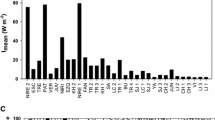Abstract
Picocyanobacterial abundance and their contribution to the total phytoplankton biomass, estimated as chlorophyll a, was investigated in 32 deep and shallow lakes. The lake series covered a wide range of natural and artificial lakes, from high altitude clear lakes and deep, large subalpine lakes through large shallow lakes, small reservoirs and fish ponds. The chlorophyll a concentrations ranged between 0.2 and 390 µg l-1. No simple relation existed between trophic state and the abundance of picocyanobacterial, mainly represented by Synechococcus spp. Below 10 µg Chl a l-1 the percentage contribution of picocyanobacteria biomass to total phytoplankton biomass exceeded 70% in some cases, whereas above 100 µg Chl a l-1, the highest contribution was only 10%. At low chlorophyll a concentrations phycoerythrin-rich picocyanobacteria (PE) dominated almost exclusively but their contribution never exceeded 10% of the total picocyanobacterial abundance when chlorophyll a concentration was higher than 50 µg l-1. Above this value there was high light attenuation and a shift of the maximum light penetration from the blue-green towards the red portion of the spectrum. In this underwater light climate phycocyanin-rich picocyanobacteria (PC) dominated. In the lakes chosen for their representation of ranges in trophy and light quality, PC cells prevailed over the PE when vertical attenuation coefficient of PAR was higher than 2.25 m-1 and red light penetrated farthest. PE cells were 100% when the vertical attenuation coefficient of PAR was lower than 0.55 m-1 and the green and blue were the most penetrating lights.
Similar content being viewed by others
References
Atlas, D. & T. T. Bannister, 1980. Dependence of mean spectral extinction coefficient of phytoplankton on depth, water-colour, and species. Limnol. Oceanogr. 25: 157–159.
Burns, C. W. & J. G. Stockner, 1991. Picoplankton in six New Zealand lakes: Abundance in relation to season and trophic state. Int. Rev. ges. Hydrobiol. 76: 523–536.
Callieri, C. & M. L. Pinolini, 1995. Picoplankton in Lake Maggiore, Italy. Int. Rev. ges. Hydrobiol. 80: 491–501.
Callieri, C., E. Amicucci, R. Bertoni & L. Vörös, 1996. Fluorometric characterization of two picocyanobacteria strains from different underwater light quality. Int. Rev. ges. Hydrobiol. 81: 13–23.
Glover, H. E., M. D. Keller & R. R. L. Guillard, 1986. Light quality and oceanic ultraphytoplankters. Nature 319: 142–143.
Hauschild, C. A., H. J. G. McMurter & F. R. Pick, 1991. Effect of spectral quality on growth and pigmentation of picocyanobacteria. J. Phycol. 27: 698–702.
Hawley, G. R. W. & B. A. Whitton, 1991. Seasonal changes in chlorophyll-containing picoplankton populations of ten lakes in Northern England. Int. Rev. ges. Hydrobiol. 76: 545–554.
Holm-Hansen, O. & B. Riemann, 1978. Chlorophyll a determination: improvements in methodology. Oikos 30: 438–447.
Iwamura, T., H. Nagai & S. Ishimura, 1970. Improved methods for determining contents of chlorophyll, protein, ribonucleic acid and deoxyribonucleic acid in plankton populations. Int. Rev. ges. Hydrobiol. 55: 131–147.
Kirk, J. T. O., 1983. Light and photosynthesis in aquatic ecosystems. Cambridge University Press, London, New York, 401 pp.
Kirk, J. T. O., 1992. A nature and measurement of the light environment in the ocean. In P.G. Falkowski & A. D. Woodhead (eds), Primary production and biochemical cycles in the sea. Plenum Press, New York: 9–29.
Kishino, M., C. R. Booth & N. Okami, 1984. Underwater radiant energy absorbed by phytoplankton, detritus, dissolved organic matter and pure water. Limnol. Oceanogr. 29: 340–349.
Krogman, D. K., 1973. Photosynthetic reactions and components of thylakoids. New York, 200 pp.
Pick, F. R., 1991. The abundance and composition of freshwater picocyanobacteria in relation to light penetration. Limnol. Oceanogr. 36: 1457–1462.
Søndergaard, M., 1990. Picophytoplankton in Danish lakes. Verh. int. Ver. Limnol. 24: 609–612.
Stainton, M. P.,M. J. Capel & F.A. J. Armstrong, 1974. The chemical analysis of fresh waters. Envir. Can. Spec. Publ. No. 5, Ottawa, 119 pp.
Stockner, J. G., 1988. Phototrophic picoplankton: An overview from marine and freshwater ecosystems. Limnol. Oceanogr. 33: 765– 775.
Stockner, J. G., 1991. Autotrophic picoplankton in freshwater ecosystems: the view from the summit. Int. Rev. ges. Hydrobiol. 76: 483–492.
Takamura, N. & Y. Nojiri, 1994. Picophytoplankton biomass in relation to lake trophic state and the TN:TP ratio of lake water in Japan. J. Phycol. 30: 439–444.
Talling, J. F. & D. Driver, 1961. Some problems in the estimation of chlorophyll a in phytoplankton. 10th Pacific Sci. Cong. Honolulu: 142–146.
Talling, J. F., 1971. The underwater light climate as a controlling factor in the production ecology of freshwater phytoplankton. Mitt. int. Ver. Limnol. 19: 214–243.
Tilzer, M.M., 1983. The importance of fractional light absorption by photosynthesis pigments for phytoplankton productivity in Lake Constance. Limnol. Oceanogr. 28: 833–846.
Tilzer, M. M., N. Stambler & C. Lovengreen, 1995. The role of phytoplankton in determining the underwater light climate in Lake Constance. Hydrobiologia 316: 161–172.
Vörös, L. & J. Padisák, 1991. Phytoplankton biomass and chlorophyll a in some shallow lakes in central Europe. Hydrobiologia 215: 111–119.
Vörös, L., P. Gulyás & J. Németh, 1991. Occurrence, dynamics and production of picoplankton in Hungarian shallow lakes. Int. Rev. ges. Hydrobiol. 76: 617–629.
Waterbury, J. B. S., S.W. Watson, F.W. Valois & D. G. Franks, 1986. Biological and ecological characterization of the marine unicellular cyanobacterium Synechococcus. Can. Bull. Fish. Aquat. Sci. 214: 71–120.
Wyman, M. & P. Fay, 1987. Acclimation to the natural light climate. In P. Fay & C. Van Baalen (eds), The cyanobacteria. Elsevier, Amsterdam: 347–376.
Rights and permissions
About this article
Cite this article
Vörös, L., Callieri, C., Balogh, K.V. et al. Freshwater picocyanobacteria along a trophic gradient and light quality range. Hydrobiologia 369, 117–125 (1998). https://doi.org/10.1023/A:1017026700003
Issue Date:
DOI: https://doi.org/10.1023/A:1017026700003




